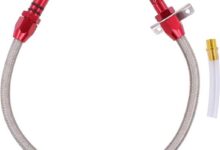5 Basic Symptoms Of Bad Oil Pressure Sensor
Last Updated on May 29, 2023 by Thomas James
Oil pressure sensors are a critical component of any vehicle’s engine. It is responsible for monitoring and regulating the level of oil pressure within the engine, ensuring that it does not become too high or too low.
Knowing how an oil pressure sensor works can help you better understand your vehicle and make sure that it is running at its optimal level. This article will explain what an oil pressure sensor is, how it functions, and why it is important to maintain the correct oil pressure in your vehicle.
Unfortunately, bad oil pressure sensors can cause a variety of problems for drivers, ranging from reduced fuel economy and increased emissions to more serious issues like engine damage.
In this article, we’ll discuss what causes bad oil pressure sensors and how to identify when they’re malfunctioning to prevent further damage to your car.
Car ownership is a responsibility, and as such, there are certain things all car owners must pay attention to. One of these essential car maintenance items is the oil pressure sensor.
If your vehicle’s oil pressure sensor isn’t working correctly, it could lead to serious problems with your engine and other components.
A faulty oil pressure sensor can be difficult to identify without the help of a professional mechanic or diagnostic tool, so it’s important for drivers to be aware of its potential issues.
The first issue that arises from a bad oil pressure sensor is an inaccurate reading on the dashboard gauge or warning light.
If either of these indicators shows something other than normal range readings, it could be an indication that the oil pressure sensor is malfunctioning.
In some cases, this may lead to false readings which could cause further damage if not addressed promptly by a qualified technician.

5 Symptoms Of Bad Oil Pressure Sensor
Randomly Blinking Oil Light
When the engine oil pressure sensor goes bad, you may get faulty readings on the oil pressure gauge. If the oil pressure reading is too low or high, this can be dangerous as it could indicate a serious problem with your car engine.
It is important to understand the symptoms of a bad oil pressure sensor so that you can address any issues before they become more serious. A randomly blinking oil light is one of these key warning signs and should not be ignored.
The purpose of an engine’s oil pressure sensor is to measure the amount of lubrication in your car’s engine and alert you when something isn’t working properly.
When this system fails, it will give incorrect readings on your dashboard gauges which can lead to a drop in performance or even engine damage if left unchecked for too long.
Strange Noises From the Engine
When it comes to vehicle maintenance, a faulty oil pressure sensor can be a major warning sign for drivers. Not only does this malfunction indicate an underlying engine issue, but it can also result in strange noises coming from the engine itself.
In order to understand how and why this happens, it’s important to know what exactly an oil pressure sensor is and how it works.
An oil pressure sensor is responsible for monitoring the amount of lubrication that enters each component of the engine during each revolution. As surfaces of parts like bearings and camshafts touch each other, they need adequate lubrication in order to function optimally and avoid damage.
The oil pressure sensor takes readings as the engine rotates, sending signals back to the electric control unit (ECU) about any changes in pressure levels inside the system.
Check Engine Light
The check engine light is a vital indicator of the proper functioning of any car. It signals that something has gone wrong with the car’s sensors, relays, or switches.
Without it, drivers would be at risk of completely unaware of serious problems developing in their vehicles.
No matter which sensor, relay, or switch fails in the car, the check engine light will always be the first and foremost indication that something isn’t working correctly.
It may not pinpoint exactly what is wrong but it does alert drivers to get their cars checked as soon as possible.
Drivers should never ignore this warning sign because doing so can often lead to further damage and even cause accidents on the roads due to mechanical failure.
If a driver notices that their check engine light has come on, they should immediately bring their vehicle into an auto repair shop for expert inspection and diagnosis.
Faulty Oil Pressure Gauge Readings
An oil pressure gauge located in the dashboard of your car is a crucial component for monitoring the health and performance of its engine.
It receives readings from an oil pressure sensor, which helps indicate how much pressure is being generated by the motor’s lubrication system. If this sensor malfunctions or goes bad, it can lead to unreliable readings on the oil pressure gauge.
This can cause a variety of problems including excessive engine wear and tear, premature failure of critical components, or poor fuel economy.
To diagnose a faulty oil pressure sensor, one should first look at the readings displayed on the car’s oil pressure gauge. If there is an inconsistency between whether your car is running or stationary, then it could be indicative of a bad sensor.
Other symptoms include reduced acceleration power when driving or difficulty starting up the engine after igniting it.
Oil Pressure Sensor Replacement
Oil pressure sensors are essential components in any engine, as they alert the driver to any potential issues in the oil system. When a vehicle’s oil pressure sensor malfunctions, it can cause serious issues with the engine and lead to costly repairs.
In order to prevent such problems from occurring, it is important for drivers to be aware of when their oil pressure sensor needs replacing.
Replacing an oil pressure sensor is not really a difficult job; however, it does require some technical knowledge to do correctly. The first step is to locate the faulty sensor and then remove it from its mounting point on the engine block or cylinder head.
This can be done with either a wrench or ratchet depending on the type of mounting used. Once removed, the new oil pressure sensor must be carefully fitted into place and tightened securely with nuts or bolts provided by the manufacturer.
When it comes time to replace an oil pressure sensor in your car, you are likely quite concerned about the cost.
Thankfully, the overall price range is not too difficult to guess: you can expect to pay somewhere between $100 and $210 for a replacement oil pressure sensor depending upon the make and model of your car.
The exact cost will depend on a variety of factors, including the specific type of sensor required for your vehicle as well as any labor costs involved in installation or removal.
The good news is that many auto parts stores carry a wide range of sensors that can accommodate most makes and models.
In most cases, you should be able to find an appropriate replacement without having to visit multiple shops or dealerships.
Conclusion
In conclusion, a bad oil pressure sensor can cause serious and sometimes irreversible damage to your car. Keep an eye out for these basic symptoms, and be sure to address them as soon as possible for the sake of your vehicle’s longevity.
Taking proactive steps in maintaining your car is essential to its performance, and this knowledge can help you prevent any further complications from arising. All it takes is a little effort to save time and money in the future.









